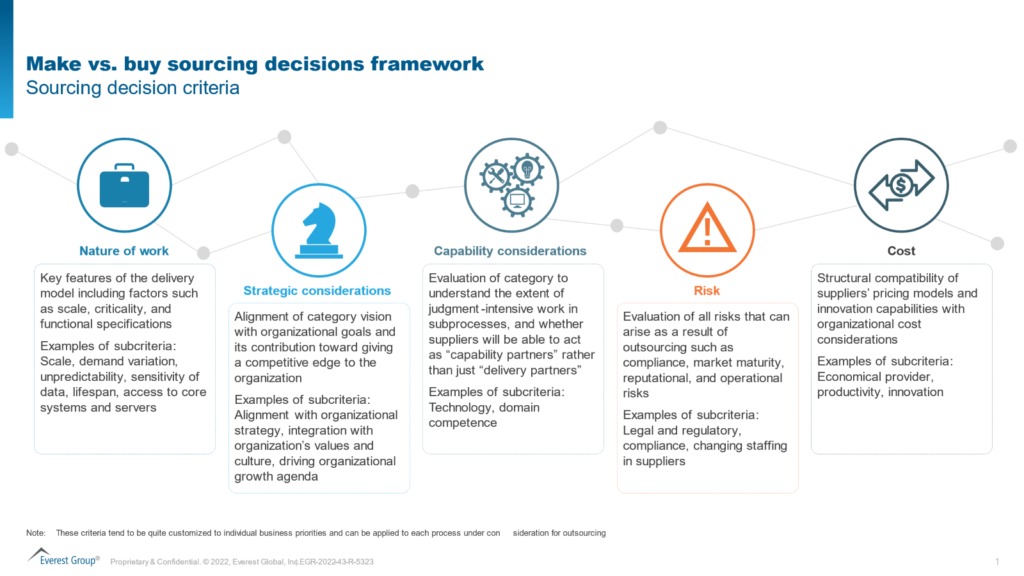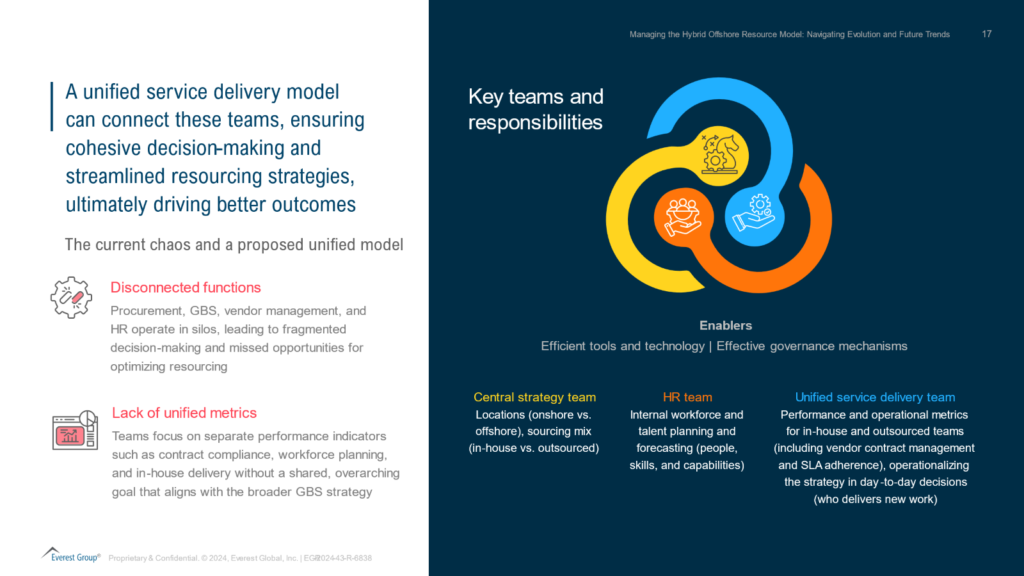
Most Global Capability Centers (GCCs) / Global Business Services (GBS) organizations find themselves facing a familiar yet increasingly complex question: Should we deliver services in-house, outsource to providers, or embrace a hybrid model?
With service delivery now a key contributor to business value, this decision isn’t just operational either, it’s strategic. As organizations grow and change, their resourcing strategies must adapt in step.
While there’s a clear intent to drive more impactful work internally and extract greater value from GBS/GCC, there is also a stronger push to tap into vendor capabilities wherever relevant.
In this latest blog, Everest Group explores why a hybrid resourcing model is emerging as the resourcing model of choice for mature GCCs/GBS organizations and how leading enterprises are now navigating this decision.
Reach out to discuss this topic in depth.
To put it simply, you’ve built the spaceship, now it’s time to decide who’s flying it and who’s fueling it.
- In-house pilots focus on strategy, innovation, and organizational vision
- Outsourced teams manage the operational engine, bringing scale and efficiency
- The hybrid approach keeps the mission on course, combining control and agility
Why are resourcing models being reconsidered?
Our recent conversations with leading GCCs/GBS organizations reveal that most revisit their resourcing decisions at key inflection points:
- Heavy reliance on a single resourcing model
- Expansion into new markets
- Operational visibility or control gaps
- Talent shortages or scalability challenges
- Dissatisfaction with current sourcing model effectiveness
However, these decisions are rarely straightforward. Most organizations take a case-by-case approach, weighing cost efficiency, control needs, internal capabilities, and risk. These decisions are also susceptible to biases that can unintentionally influence the outcome like:
- Expedience: Favoring tried-and-tested models for quick certainty
- Past experience: Letting previous vendor engagements influence decisions
- Visibility bias: Favoring providers with more face time over better-positioned offshore or nearshore GCCs/GBS
So, how can organizations ensure they’re making the right resourcing decisions?
Here are a few critical steps to guide the process.
First, understand where you stand
We believe that organizations typically fall into one of four personas along the hybrid resourcing maturity spectrum. Knowing your current position, and your desired destination helps lay the foundations for a strategy that aligns with your business’ objectives.
Second, utilize an established framework to assess sourcing priorities
To make more objective, informed decisions, use a proven approach like the Make vs. Buy Sourcing Decisions Framework, a core component of Everest Group’s sourcing methodology. This framework enables organizations to decide whether to deliver services in-house, engage external vendors, or adopt a mix of both.
The in-house “make” model offers control, economies of scale, and safeguards for intellectual capital, ideal for critical or high intellectual property functions.
The outsourced “buy” model, on the other hand, provides cost efficiencies, flexibility, and easier access to non-core capabilities, especially beneficial in uncertain labor markets.
When to use which model?
The Make vs. Buy framework evaluates five key dimensions to guide your resourcing decision:

Third, recognizing key stakeholders involved in resourcing decisions
A crucial step in building an effective resourcing strategy is identifying the various stakeholders involved in the decision-making process. In leading organizations, multiple stakeholders independently influence resourcing choices, including executive leadership, GBS/GCC leadership, the Vendor Management Office (VMO), and the Human Resources (HR) function
Despite each group’s critical contribution, these teams often operate in silos, using different success metrics and decision criteria. The result? Fragmentation, misalignment, and inefficiencies across the provider and internal delivery ecosystem.
And finally, adopt a unified service model
To overcome this, organizations must adopt a unified governance model that brings these stakeholders together with shared goals, common metrics, and aligned accountability across the sourcing lifecycle.
To bring this model to life, Everest Group recommends activating the Power Trio:
- A central strategy team to define direction and ensure alignment
- HR to lead talent planning and workforce strategy
- A unified service delivery team to execute seamlessly across delivery models

Everest Group’s recommendations
To make better resourcing decisions and reduce bias, we recommend:
- Assessing your hybrid maturity, based on Everest Group’s Four Personas of Hybrid Resourcing
- Using a structured sourcing decision framework, like our Make vs. Buy modelto methodically evaluate each resourcing choice
- Deploying the Power Trio to develop a unified model
- A central strategy team
- HR for talent planning
- A unified service delivery team
- Reframing relationships with providers to align with your enterprise objectives

Continue exploring:
To discuss resourcing strategies and to hear more about the GBS and Shared Services and Sourcing and Vendor Management offerings today, please contact Anish Agarwal ([email protected]), Kushagra Singh ([email protected]), Khushboo Hanjura ([email protected]) and Mudra Jain ([email protected]).











